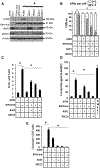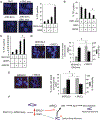Mutant IDH1 Cooperates with ATRX Loss to Drive the Alternative Lengthening of Telomere Phenotype in Glioma
- PMID: 29545335
- PMCID: PMC10578296
- DOI: 10.1158/0008-5472.CAN-17-2269
Mutant IDH1 Cooperates with ATRX Loss to Drive the Alternative Lengthening of Telomere Phenotype in Glioma
Abstract
A subset of tumors use a recombination-based alternative lengthening of telomere (ALT) pathway to resolve telomeric dysfunction in the absence of TERT. Loss-of-function mutations in the chromatin remodeling factor ATRX are associated with ALT but are insufficient to drive the process. Because many ALT tumors express the mutant isocitrate dehydrogenase IDH1 R132H, including all lower grade astrocytomas and secondary glioblastoma, we examined a hypothesized role for IDH1 R132H in driving the ALT phenotype during gliomagenesis. In p53/pRb-deficient human astrocytes, combined deletion of ATRX and expression of mutant IDH1 were sufficient to create tumorigenic cells with ALT characteristics. The telomere capping complex component RAP1 and the nonhomologous DNA end joining repair factor XRCC1 were each downregulated consistently in these tumorigenic cells, where their coordinate reexpression was sufficient to suppress the ALT phenotype. RAP1 or XRCC1 downregulation cooperated with ATRX loss in driving the ALT phenotype. RAP1 silencing caused telomere dysfunction in ATRX-deficient cells, whereas XRCC1 silencing suppressed lethal fusion of dysfunctional telomeres by allowing IDH1-mutant ATRX-deficient cells to use homologous recombination and ALT to resolve telomeric dysfunction and escape cell death. Overall, our studies show how expression of mutant IDH1 initiates telomeric dysfunction and alters DNA repair pathway preferences at telomeres, cooperating with ATRX loss to defeat a key barrier to gliomagenesis.Significance: Studies show how expression of mutant IDH1 initiates telomeric dysfunction and alters DNA repair pathway preferences at telomeres, cooperating with ATRX loss to defeat a key barrier to gliomagenesis and suggesting new therapeutic options to treat low-grade gliomas. Cancer Res; 78(11); 2966-77. ©2018 AACR.
©2018 American Association for Cancer Research.
Conflict of interest statement
Disclosure of Potential Conflicts of Interest
No potential conflicts of interest were disclosed.
Figures






References
Publication types
MeSH terms
Substances
Grants and funding
LinkOut - more resources
Full Text Sources
Other Literature Sources
Medical
Research Materials
Miscellaneous

